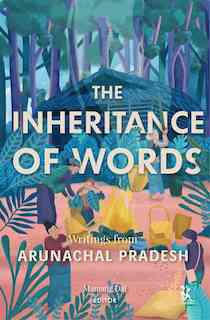
The Inheritance of Words: Writings from Arunachal Pradesh edited by Mamang Dai
More about Fiction & Poetry >>
Arunachal Pradesh, recognized as one of the hotspots of biodiversity is home to a range of economically important plants. Some of these plant species have found use in the preparation of natural dyes. Natural dyes are colourants having several applications in textiles, inks, cosmetics, etc. Nature has gifted us more than 500 dye-yielding plant species. […]
Arunachal Pradesh has 25 major tribes and 125 sub-tribes broadly belonging to the Indo-Mongoloid racial stock, with varied composition of cultural diversity. The major tribes are Adi, Aka, Apatani, Bangni, Hill Miri, Idu, Khawa, Khamba, Khamti, Lisu or Yobin, Memba, Miji, Mishimi, Monpa, Nah, Nocte, Nyishi, Sherdukpen, Singpho, Sulung, Tagin, Tangsa and Wancho. The ethnic groups inhabiting different areas of the state have indigenous knowledge systems and have evolved methods for utilizing the vast plant resources available. Floral diversity is the main source of raw materials being used traditionally by the indigenous people of the north-eastern states as food supplement, for fodder, fibres, construction, handicrafts, beverages, colouring agents (dyes) and more importantly, in health care practices. Their knowledge in utilizing these resources is characteristic and differs from tribe to tribe. Earliest evidence for the use of natural dyes dates back to more than 5000 years, with Madder (Rubia cordifolia) dyed cloth found in the Indus river valley at Mohenjodaro. India is endowed with a wealth of natural flora and fauna, which provide the basic resources for a rainbow of natural dyes. Natural dyes are environment friendly; for example, turmeric, the brightest of naturally occurring yellow dyes is a powerful antiseptic and revitalizes the skin, while indigo yields a cooling sensation. Research has shown that synthetic dyes are suspected to release harmful chemicals that are allergic, carcinogenic and detrimental to human health. Ironically, Germany that discovered azo dyes, became the first country to bancertain azo dyes in 1996. The aim of the present study has been to investigate the availability of natural dye-yielding plant species in Arunachal Pradesh and gather information on traditional knowledge system associated with extraction and use of natural dyes by the tribal population. Organic dyeing not only helps preserve the traditional art of weaving and design, but also provides employment and yields economic and ecological benefits. […]
Source: “Natural dye-yielding plants and indigenous knowledge on dye preparation in Arunachal Pradesh, Northeast India” by Debajit Mahanta & Saurabh Tiwari in Current science (Research Communications, 2005)
URL: https://www.academia.edu/28861649
Date Visited: 26 October 2021
[Bold typeface added above for emphasis]

Learn more about natural dyes by using the search field seen below or here >>
“If we take action, the right action – as the report [on Biological Diversity] proposes – we can transition to a sustainable planet.” […] Many good things are happening around the world and these should be celebrated and encouraged […] We have to act now. It is not too late. Otherwise, our children and grandchildren will curse us because we will leave behind a polluted, degraded and unhealthy planet.” – Elizabeth Maruma Mrema, executive secretary, UN Convention on Biological Diversity – “Extinction: Urgent change needed to save species, says UN”, BBC News, 15 September 2020 >>

Watch the video on BBC News | More about Biodiversity in India >>
“Once, I was walking with this young tribal girl through the forest and we stumbled upon a tuber. She plucked it, cut the eye of the tuber and buried it in the mud before taking it to be cooked. I asked her why she did so and she replied ‘If I don’t put it back, how will it grow again?’ and that moment made me realise how sensitive tribals are towards environment and nature. For them, putting back what they take is inherent in their culture and lifestyle.” – Mari Marcel Thekaekara (writer and Co-Founder of ACCORD-Nilgiris) | Learn more >>
“Jungle is a living entity and it also communicates, provided we have the ability to listen to it. […] The three essential components—forests, tribal forest dwellers and life forms living in forests—complement one another and are not rivals.” – Former environment minister A.M. Dave >>

“The recent trend is to use exotic species for manicured lawns and gardens. This means indigenous species are losing even more space, and our local species decline with them. New lifestyle patterns are also changing things. For example, India’s urban sparrow population has dipped. Even growing up, sparrows were as common as a crow or a pigeon. But now they’ve almost disappeared. Why? For one thing, our architecture is changing, and building facades no longer offer nesting sites. Even the old grain shops, which used to have grain strewn in the road, have turned into packaged super markets. Suddenly, you have an entire species disappearing because you’ve taken away its food source, habitat, and flight path.” – Rashneh Pardiwala, Centre for Environmental Research and Education (CERE) in Mumbai (Asia Blog, 27 July 2015)
Tips for using interactive maps
Toggle to normal view (from reader view) should the interactive map not be displayed by your tablet, smartphone or pc browser
For details and hyperlinks click on the rectangular button (left on the map’s header)
Scroll and click on one of the markers for information of special interest
Explore India’s tribal cultural heritage with the help of another interactive map >>
“The uniqueness of northeast states of India lies in their cultures” | Learn more >>
In Marginalised but not Defeated, Tarun Kanti Bose (a seasoned public interest journalist) “talks about the Khasis, Nagas, Karbis, Garos, Rabhas, Misings, Daflas, Bodos, Akas and others in the North-east. […] The mainstream development paradigm is being questioned and new rainbows of collective, community reassertions are happening across the tribal belt in India. More so, in most cases, led by brave, empowered and resilient women.” | Learn more: https://countercurrents.org/2023/05/book-review-marginalised-but-not-defeated >>
Up-to-date reports by Indian journalists and commentators
To search Indian periodicals, magazines, web portals and other sources safely, click here. To find an Indian PhD thesis on a particular tribal community, region and related issues, click here >>
Search tips
Combine the name of any particular state, language or region with that of any tribal (Adivasi) community.
Add keywords of special interest (music, poetry, dance just as health, sacred grove and biodiversity); learn about the rights of Scheduled Tribes such as the “Forest Rights Act” (FRA); and the United Nations “Declaration on the Rights of Indigenous Peoples”, “Universal Declaration of Human Rights”, “women’s rights”, or “children’s right to education”.
Ask a question that includes “tribal” or “Adivasi”, for instance: “Adivasi way of life better?” (or “tribal way of life worse?”)
Specify any particular issue or news item (biodiversity, bonded labour and human trafficking, climate change, ecology, economic development, ethnobotany, ethnomedicine, global warming, hunter-gatherers in a particular region or state, prevention of rural poverty, water access).
For official figures include “scheduled tribe ST” along with a union state or region: e.g. “Chhattisgarh ST community”, “Himalayan tribe”, “Scheduled tribe Tamil Nadu census”, “ST Kerala census”, “Particularly Vulnerable Tribal Group Jharkhand”, “PVTG Rajasthan”, “Adivasi ST Kerala”, “Adibasi ST West Bengal” etc.
In case the Google Custom Search window is not displayed here try the following: (1) toggle between “Reader” and regular viewing; (2) in your browser’s Security settings select “Enable JavaScript” | More tips >>
Note: hyperlinks and quotes are meant for fact-checking and information purposes only | Disclaimer >>
There are over 700 tribes (with overlapping communities in more than one State) which have been notified under Article 342 of the Constitution of India, spread over different States and Union Territories of the country. The largest number of main tribal communities (62) has been specified in relation to the State of Orissa. The Scheduled Tribes have been specified in relation to all the States and Union Territories except Haryana, Punjab, Chandigarh, Delhi, and Pondicherry.
Source: National Commission for Scheduled Tribes (NCST), Government of India, Ministry of Tribal Affairs, FAQ accessed on 14 September 2021
Regions noted for their wealth of tribal heritage: culture & ecology
Nilgiri Biosphere | Bake Restudy Project (UCLA Digital Library)
Regional Zonal Cultural Centres
Eastern Zonal Cultural Centre, Kolkata
Eastern region – Eastern Zonal Council
North Central Zone Cultural Centre, Prayagraj
Uttar Pradesh
North East Zone Cultural Centre, Dimapur
Seven Sister States & Sikkim – North Eastern Council
North Zone Cultural Centre, Patiala
Northern region – Northern Zonal Council
South Central Zone Cultural Centre, Nagpur
Central region – Central Zonal Council
South Zone Cultural Centre, Thanjavur
Southern region – Southern Zonal Council
West Zone Cultural Centre, Udaipur
Western region – Western Zonal Council
——————-
Up-to-date information: Zonal Cultural Centres >>
Learn more
Crafts and visual arts | Fashion and design | Masks
eBooks, eJournals & reports | eLearning
eBook | Background guide for education
Forest dwellers in early India – myths and ecology in historical perspective
Himalayan region: Biodiversity & Water
History | Hunter-gatherers | Indus Valley | Megalithic culture | Rock art
Languages and linguistic heritage
Modernity | Revival of traditions
Tribal Research and Training Institutes with Ethnographic museums